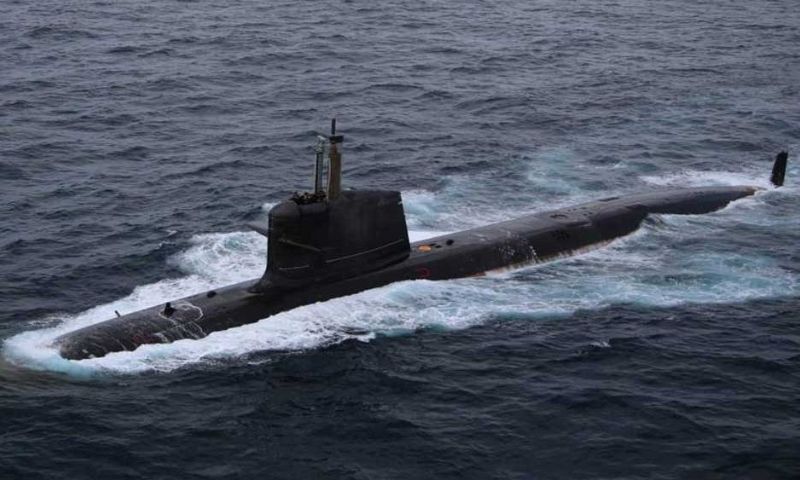NEW DELHI: The Indian Navy has started extensive sea trials of its third nuclear-powered ballistic missile submarine (SSBN), INS Aridhaman, raising alarms among neighboring countries about its aggressive defence trajectory.
The move marks another in India’s military expansion and underlines its continued investment in nuclear capabilities.
Independent defence analysts say this development reflects growing concerns over India’s militarisation and its aggressive posture in the region.
The 7,000-tonne submarine is expected to be formally inducted into the Indian Navy by the end of 2025, according to Defence News of India.
Indian Navy said the completion of these trials will mark a major step forward in strengthening its nuclear triad and ensuring a robust, sea-based nuclear deterrent.
The vessel is being developed under the Advanced Technology Vessel (ATV) project at the Ship Building Centre in Visakhapatnam.
As a next-generation platform, it surpasses its predecessors—INS Arihant and INS Arighaat, commissioned in 2016 and 2024 respectively—not only in size but also in capability, Defence News of India reported.
Unlike the earlier SSBNs, Aridhaman has been designated the first vessel in the new S4 class, incorporating major technological upgrades. According to the defence experts, it is one of the most advanced submarines in India’s fleet, according to Defence News of India.
Indian Navy's Third Nuclear SSBN, INS Aridhaman, Enters Final Phase of Extensive Sea Trials, Formal Induction Expected by 2025 End#india #defence #defencenews #indiannavy pic.twitter.com/dWYiL9U6Xg
— Defence News Of INDIA (@DefenceNewsOfIN) August 22, 2025
With a displacement of around 7,000 tonnes, it is approximately 1,000 tonnes heavier than its forerunners. At the heart of Aridhaman is a more advanced 83 MW Pressurised Light-Water Reactor, developed by the Bhabha Atomic Research Centre (BARC), Defence News of India reported.
This upgraded reactor not only delivers greater power but also boasts a significantly reduced acoustic signature, enhancing the submarine’s stealth and making it extremely difficult to detect.
The submarine can reach submerged speeds of up to 24 knots (about 44 km/h), and its endurance is limited only by the duration of food and supplies available to the crew, underscoring its strategic long-range patrol capabilities, according to Defence News of India.
This development signals a clear escalation in India’s underwater nuclear deterrence posture and has raised regional concerns about New Delhi’s increasing focus on military expansion and war-driven ambitions.
Defence News of India reported that the submarine is equipped with eight vertical launch tubes, doubling the four found on INS Arihant and INS Arighaat. This allows it to carry a more potent arsenal, such as eight K-4 missiles with a range of 3,500 km or a larger loadout of 24 K-15 Sagarika missiles (750 km range).
This increased firepower enables the submarine to target distant strategic locations from the relative safety of Indian territorial waters, solidifying the nation’s second-strike capability, which is a fundamental element of its no-first-use nuclear policy.
Expert says its commissioning comes at a pivotal moment for regional security in the Indian Ocean Region (IOR), amid growing geopolitical tensions and shifting naval dynamics.
Earlier this week, India “successfully” conducted the maiden flight tests of the Integrated Air Defence Weapon System (IADWS), Defence Minister Rajnath Singh announced.
Indian naval chief blames PM Modi
Meanwhile, Indian Chief of Naval Staff Admiral Dinesh Kumar Tripathi has accused Prime Minister Narendra Modi’s government of preventing the military from striking Pakistan, a decision he said led to heavy losses for the Indian Air Force during May’s air combat.
During the May clashes, Pakistan downed six Indian fighter jets, including Rafale, destroyed S-400 air defence systems and several drones, and disabled several airbases in the confrontation.
The clashes followed weeks of rising tension after an attack on 22 April in Indian Occupied Kashmir’s Pahalgam area, where unidentified gunmen killed 26 people.
Speaking at a ceremony in Andhra Pradesh during the commissioning of two new fighters, Admiral Tripathi said that the military was not granted clearance to inflict damage on Pakistan for political reasons.


























